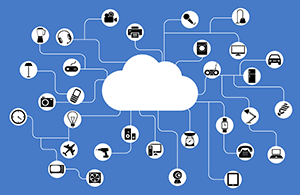 Do you own an internet-connected device other than your phone and computer? Most of us do, whether it’s a smartwatch, fitness tracker, baby monitor, or even your car. In fact, researchers predict there will be more than 20 billion internet-connected devices in use by 2020.
Do you own an internet-connected device other than your phone and computer? Most of us do, whether it’s a smartwatch, fitness tracker, baby monitor, or even your car. In fact, researchers predict there will be more than 20 billion internet-connected devices in use by 2020.
These connected devices make our lives easier and can provide peace of mind. Knowing that you did in fact turn off the oven or that your cat is doing just fine while you’re on vacation is nice. But what if someone else was able to view and record video of your home or steal personal data from your Fitbit?
These are the dangers of new technology being a step or two ahead of information security. We get frequent reminders to change passwords and keep antivirus software up-to-date, but we don’t hear much about securing other types of devices. These products, which collectively are referred to as the Internet of Things (IoT), are vulnerable to the same attacks that threaten our computers and mobile devices.
Last October, there was a widespread outage of major websites, including Netflix, Twitter, and Spotify. The outage lasted for hours and was the result of a distributed denial-of-service attack (DDoS). These types of attacks involve sending a flood of traffic to a website in order to overwhelm its resources. Often, this traffic is generated by using large numbers of computers infected with malware to help attack a website. DDoS attacks have long been a popular tool among cyber criminals, but this one had a relatively new wrinkle—many of the devices involved were security cameras and other internet-connected devices.
Ensuring the security of internet-connected devices is a major concern. While your DVR probably wasn’t involved in this recent attack, that doesn’t mean that it—and other devices in your home—aren’t vulnerable to attacks. Large-scale efforts are underway in both the government and private sectors to improve security for IoT devices and getting it right is critically important as threats continue to evolve.
While this work is ongoing, there are several steps you can take right now to secure your devices:
- The easiest is to ensure that your home network is secure by creating a strong WiFi password and enabling your router’s firewall. Check with your internet service provider for how-to guides to getting this done.
- Another important step is to keep your devices and home network equipment up-to-date. Periodically check for updates to your devices and don’t ignore alerts or notifications from device manufacturers requesting that you run an update.
- Lastly, decide what devices actually need to be connected to the internet. Consider the advantages of connecting and assess whether it’s worth the risk. You probably want to be able to check your home security system from your phone, but it’s very likely that a toaster oven can do its job without being online.
 Simmons is a frequent target of phishing attacks, in which criminals attempt to obtain personal information, gain access to your email account, or compromise your computer. Links in phishing emails may take you to websites that look very much like services you use, and attachments in phishing emails are a prime source of viruses and malware.
Simmons is a frequent target of phishing attacks, in which criminals attempt to obtain personal information, gain access to your email account, or compromise your computer. Links in phishing emails may take you to websites that look very much like services you use, and attachments in phishing emails are a prime source of viruses and malware. As we begin the spring semester, we want to share our progress on the computer replacement project.
As we begin the spring semester, we want to share our progress on the computer replacement project.